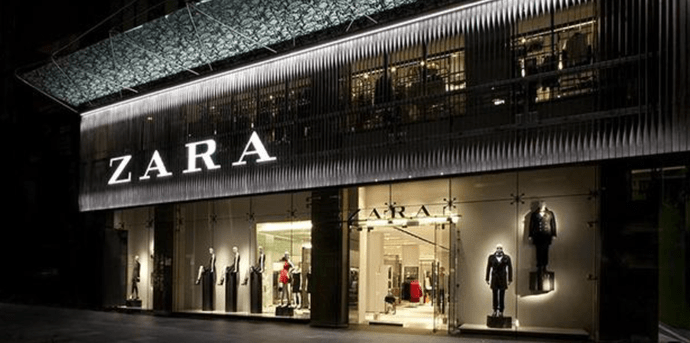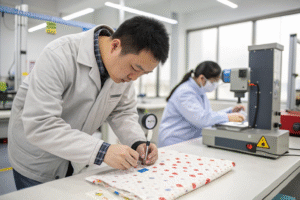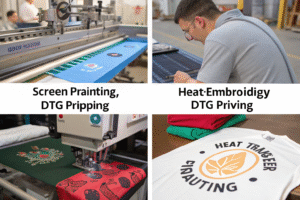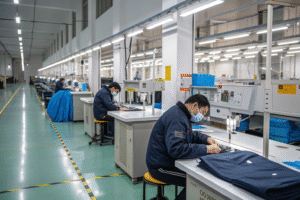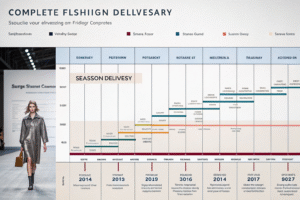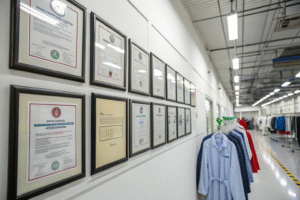The real threat often does not come from direct competitors.
Takeout food hurts instant noodles. Online payment hurts banks. But, who is hurting Zara?
The garment industry's actual enemy is inventory.
Once inventories are high, companies are like toppling dominoes.
If we do not decrease the inventory, there is a risk that the capital chain reaction will break.
When companies give discounts to lessen the inventory, profit numbers might get ugly. They are also compromising the brand's image.
Even powerful brands suffer on high inventory. And taking the risk is something they cannot avoid.
It is Zara's responsive, flexible supply chain strategy that is the envy of Chinese brands.
With Zara's fast digital process and the new speed of 7 to 14 days, other brands cannot catch up.
Their supply chain is the perfect way to avoid inventory risk. It also allows the company to ask clothes manufacturers to replicate brands at a super-fast rate. Thus, they can bring the products of top fashion week to ordinary homes.
However, Zara has not been able to stop the global trend of closing stores. Their business shrunk in a time when many clothing brands have not been successful in China. And yet, it has held up well better than other fashion brands.
But Zara recently announced that it would close all of its brick-and-mortar stores in China. It includes Bershka, Pull&Bear, and Stradivarius brands. They will leave only their website and other e-commerce channels active.
China's fast fashion revolution, it seems, has not spared Zara.
Is the flexible supply chain on which Zara prides itself broken?
Who's really killing fast fashion?
The one that "hurts" Zara was not what you expect
Copying other fashion brands is no excuse for Zara's survival. The tens of millions of dollars paid by Zara every year in lost damages for copying are enough to explain it all. But compared with 28.291 billion yuan in profits for one year (in 2019), these lost lawsuits pale in comparison.

Zara has gained fashion followers by quickly getting customers to wear the same design as fashion week look. They use a no-print strategy of not showing the brand name. And the lack of a visible logo makes the products come from big fashion brands.
Even if the product is not attractive, a passing fashion trend does not need a piece of clothing to provide lasting value.
But Zara has recently slipped into China. Some are saying that the large number of items available in Taobao is the same as Zara's. And it hit Zara badly.
Zara's copycat methods have been copied by e-commerce. This method makes it cheaper for customers to get their hands on fashion week knockoffs. They offer lower costs and thinner margins.
When Chinese e-commerce has gone Zara's way, it leaves Zara with nowhere to go.
Sounds reasonable at first.
Whether it is Taobao, Weidian, or today's Pinduoduo, the history of the rise of e-commerce platforms is also the history of copycat products.
Almost all e-commerce platforms rely on the rise of the flow advantage of copycat products. After that, when the volume is big enough, they will be cutting prices.
But was it really a Zara knockoff that hurt Zara?
This author researched and summarized the categories of women's wear and men's wear on Taobao and Pinduo platforms with curiosity.

Zara's direct competitors
Go search for women's wear on Taobao and sort by sales. Now, what do you see?
Uniqlo and some white-label hot styles are flooding in on the Internet.
H&M, BoSideng, and ADI can be seen occasionally among the women's favored dresses. And their monthly sales volume is over a thousand.
It is the same for men's wear. And it's hard to ignore Antarctic, Yu Zhaolin, fake Nike, fake Armani due to its prominence.
Pinduoduo, since it caters to different groups, has a big price difference. It is about 10 yuan of clothing sales at every 100,000 +.
From the brand perspective, Pinduoduo covers white brands, such as the South Pole, North Pole Velvet, Yu Zhaolin.
Of course, some might argue that they don't think fashion-forward Zara under the mass-market category. And consumers of trending products are not its target audience.
But to say that Uniqlo's booming online sales have no impact on Zara is undoubtedly not true.
At the very least, the results of the men's and women's online sales rankings prove that not all FMG brands are dead. And that Yanai is as smart and as efficient as Uniqlo's primary, cost-effective, online and offline offerings.
No one can avoid counterfeit, but the mainstream channels are not steady. High-quality and premium counterfeit products will continue.
Compared with Uniqlo, Zara's commitment to embracing the online world is not enough.
Before, it was not a thing. But in this epidemic, it is now a matter of life and death when it comes to their sales.
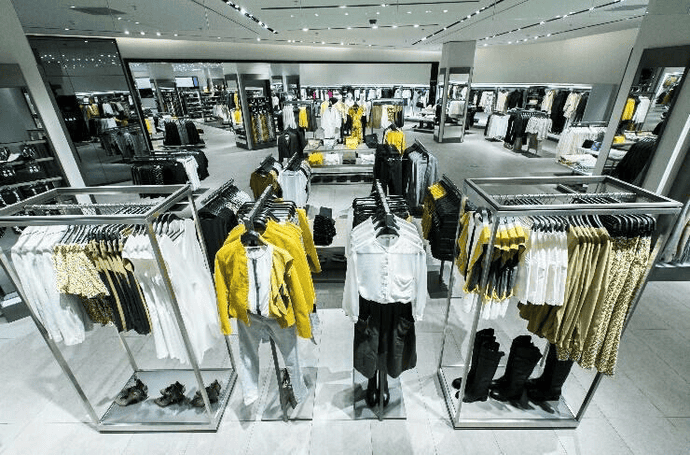
Zara's current status
Zara secures clothes manufacturers to produce 120,000 fashion categories per year. Each of which is produced in small batches to reduce the strain on inventory caused by its large SKUs.
But under the influence of the epidemic, this supply chain failed.
Scattered throughout the global supply chain and a missing link will lead to system breakdown.
The shutdown of offline stores will inevitably lead to high inventories, leading to a vicious circle.
Inditex, Zara's parent company, reported a first-ever net loss of more than 3.2 billion yuan from February to April 2020. This data drove them to close more than 1,000 Zara stores, the company said in its financial statement.
Offline markets in Europe and the United States have been severely affected, according to Visa. In contrast, online spending has increased.
Supreme's revenue, which accounts for 60% of online sales, is not what you will consider bad. But for Zara's, that data isn't.
An outburst of "digital residents" "lost" offline consumers under the epidemic outbreak. This trend forced the retail industry to turn digital.
Can Zara find success online?
One can not build online marketing success overnight. Following the Internet, it needs a complex supply chain transformation.
There should be systematic cooperation between e-commerce front-end and production, inventory, warehousing, logistics, etc.
When they cannot sell the product or a hard sell, which leads to massive losses, the gain outweighed the loss.
If Zara did not find an effective way to transform online during the epidemic, coping could be difficult.
Zara and H&M are not entirely missing from the list of products that sell more than 1,000 copies a month on Taobao.
Unlike Uniqlo, the top seller and sells at total price, the other two brands make a list with discounted products. They sold the products at half the price.
Users of Zara's products on the list are still asking whether the product is bleached or pilling.
Zara has no advantage in China in terms of cost performance, the reason for dropping.
However, some of the world's leading designers and consumers still support Zara. People are still willing to pay for it.
But it is uncertain for the brand as they find it hard to prosper with no edition and no-cost performance. Under the epidemic, the typical situation arises. It is a matter of "protecting the big and protecting the small." And these days, it is inevitable to protect the big ones.
The live-streaming industry is closing in on Zara
There was a time when competition in the clothing market was not so tough.
In the case of limited access to consumers, the market with broad reach rules.
In the past, Smith Barney relied on advertising to build a wide range of users' knowledge. They then opened stores to accommodate the people shopping in physical stores. This system gave them a lying profit.
These days, the Internet influences consumers. There is also an abundance of channels. And it becomes difficult for any brand to penetrate those channels.
Under a normal situation, the notion of national consumption tends to be reasonable. There's a high-cost performance whether the products have a brand or come from a famous brand.
Product cost performance has reached an unprecedented height.
The apparel industry has two weak points. One is the high inventory. The inventory of traditional clothing brands is generally around 50%. And the industry's initially thin profit is heavily overstocked in the inventory.
Second, the upstream and downstream are separated. There is no benefit-sharing among raw material suppliers, factories, and brand enterprises.
All of these weak points drive up product premiums and thus weaken market competitiveness.
Whoever solves these problems will be able to produce more cost-effective products.

Live broadcast, lifesavers
The development of China's e-commerce continues to hit these weak points. Those who want to catch up with ZARA's supply chain have advantages.
New retail, unbounded retail, omnichannel, KOL, all go live.
In recent years, an endless stream of "new terms" has been reshaping business logic.
In 2018, Taobao basically displayed 40 products for each live broadcast. Their 800 products for 20 shows in a month and 8,000 products for ten anchors equals Zara's.
The popular e-commerce live broadcast is a big hit. Most of the summer and autumn clothes in Hangzhou and Guangzhou sell out in September and October.
In 2019, apparel products accounted for 46% of profits online. This category has the most significant transaction volume.
Under the epidemic condition, live broadcast has even become a lifesaver for many brands.
In the first half of 2020 alone, they put on more than 150 million times of clothing, shoes, hats, needles, and textiles on the shelves of the broadcast studios. This data accounts for 41.7% and 53.2% of SKUs.
This year, not only do small shop owners turn to live broadcasts, but also Burberry. Some of these luxury brands also catch up with the start of live online selling.
Under the trend of mass distribution, the influence of traditional brands is declining. In contrast, many online store brands are rising. They have become a force that cannot be ignored in the market. Some brands are even preparing to go public.
"Starting power depends on the flow of life and death supply chain," this is the consensus of the live-streaming patrons. They challenge the traditional retail market.
Online sellers strategies
The garment industry supply chain based its production on materials and capacity. To keep up with the demands, the sale channels selling clothes give their orders to clothes manufacturers 4 to 6 months in advance.
During the early stages of the traditional women's clothing supply chain, this strategy is a gamble. Producing one design in thousands could either fail or succeed. But the risk in capital investment is always very high.
One such example is Heilan Home's. In 2018, their inventory was 9.47 billion yuan. It is three times the profit of the year.
Taobao's online celebrity women's clothing store changed this pattern.
E-commerce companies do not need the whole collection (various categories in spring, summer, autumn, and winter). As long as individual products sell well, they do fine.
This system reduces the cost, small batch of high frequency on the new, agile production. It also ensures the diversified aesthetic needs of users to avoid the embarrassment of matching shirts.
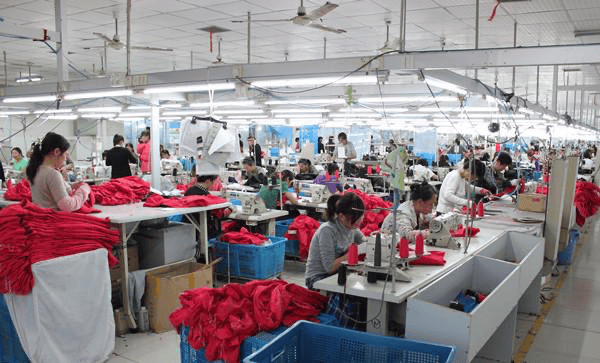
The most significant advantage of live-streaming
The biggest advantage of the live selling of products lies in zero inventory.
This results in cutting short the sales cycle of goods continuously.
What takes in the offline industry three months to do, it only takes online minutes.
What's more, there is only one sample of clothes for live broadcasting.
Consumers and the supply chain can simultaneously see the live streaming earnings with zero inventory.
After the live broadcast, there is an order. In China's efficient closed-loop market, the excellent supply chain can achieve production and delivery within 48 hours through the cooperation of all parties.
Hangzhou is surrounded by numerous garment manufacturers and OEM processing enterprises. Anchors on some platforms will bypass merchants and brands. They will directly connect with clothes manufacturers to produce goods.
Head online celebrity endorsers use the self-built supply chain to solve traditional inventory with high sale results.
To deliver goods within 48 hours, the rapid response capability of the supply chain is challenging.
With the support of the "fast reverse" supply chain, online stores choose unprepared materials. With 40 kinds of fabrics, clothes manufacturers can complete about 250 SKUs or 500 SKC of garments. This speed makes the post-production, manufacturing, and order make it effective.
Online stores offer something new every week and hundreds of inventory in a short but fast way.
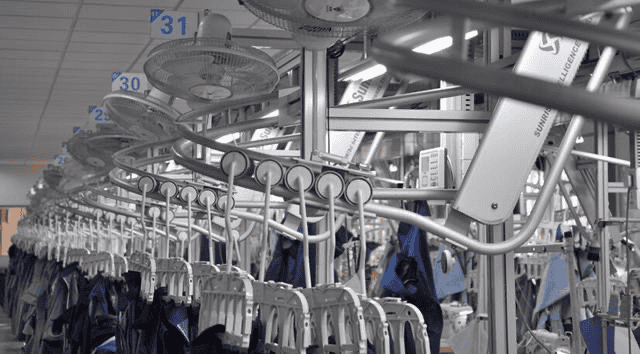
Live broadcasting also helps the garment industry
Digital capability in the production process is a prerequisite for rapid response.
The garment industry is non-standardized. And the degree of hardware is relatively low in the industry, at 80% of the production process is completed manually.
Flexible production hardware such as an intelligent cutting system and logistics transmission belt also further improves the flow's response speed.
Besides, the channel can optimize the raw material, the process, and style of SKU single products. And they can more precisely capture the changing trend. So, there is the possibility of creating the ultimate single product.
With the help of celebrity endorsers, one style can be hot-selling.
Therefore, live broadcasting is an overall new process for the garment industry.
Broadcast rebuilds C2B mode into C2K2B mode (C= customer, K=KOL, B= channel).
Going live makes up for the lack of user experience in online buying. They show the customers how to wear the clothes rather than simply selling.
The charming personality of anchors makes the products more desirable.
The support of many consumers also makes the product popular and trending.
These factors have accelerated the rise of niche brands.
Greater forces to disrupt Zara
The center of a successful, cost-effective product is knowing the consumers' demands (simplify complexity) and a robust supply chain support (reduce costs). This is the standard BBB1 formula obtained by the Taobao special price team after analyzing industry data.
No one can separate the popularity of online sellers from the support of a fast reverse supply chain. More importantly, it cannot be separated from the industrial background of big data and clustering.
For decades, brands have been influencing consumer decisions.
They relied on traditional media such as movies, TVs, and radios to attract consumers' attention. These brands control consumers' minds, and they have virtually controlled consumers' shopping decisions.
But with the rise of social media, the web, and intelligent algorithms, people's attention has become diverse.
Different modes of communication have also become more accessible to the mass.
Unlike previous e-commerce channels, live streaming has almost no search function.
The algorithm matches the tags in the broadcast room.
Extensive data tag coordination between anchors and users lead the consumers to different broadcast rooms.
The e-commerce platform has rich, three-dimensional user data, which Zara can't match.
While Zara knows how much clothing each store has sold, the online platform can identify the buyer, what she wants to buy, and where it is available.
Are these threats to Zara?
Cave, the head of the Taobao industry, even said that the soul of Chinese fast fashion lies in Taobao. And iFashion is the largest fast-fashion brand in China.
They want to build data-driven personalized, customized, intelligent "new retail" enterprises.
Alibaba has set up a world-class IT team and solved the "big data" problem in product sales.
Its own sales platform records and tracks all kinds of sales data. It can quickly perceive the direction and trend of market demand for products. With this technology, merchants have what they need to reduce inventory.
Alibaba's much-hyped shop, the Xunxi Factory, aims to transform the supply chain by simplifying and tricking the simplest processes.
It will be scattered in every link of the supply chain to achieve flexible, personalized, multi-track management through the digital way.
Although the results have not yet been fully materialized, Ali's ambition to surpass Zara's social supply chain is evident already.
Improving the efficiency of the supply chain
To improve the efficiency of the supply chain, starting at integrating the industrial cluster is a good way.
From north to south, the apparel industry mainly concentrated in four areas: link Bohai sea area (Hebei Cangzhou - live pearl base, Shandong Linyi - live and creamy base), the Yangtze river delta region (Jiangsu Changshu ink river fur live base, Zhejiang - Hangzhou chariot and live base), Fujian area (base - Fujian Shishi green gen city live) the pearl river delta region - Mars base in Guangzhou, Guangdong).
With the support of historical accumulation, policies, and capital, the industrial cluster has become the soil for the outbreak of online clothing stores, contributing a lot to cost reduction and an increase in inefficiency.
The popularization of 5G technology will provide a broader space for China's digital supply chain.
In the near future, even designers in New York and consumers in Milan, who are thousands of miles away, will be able to create the clothes consumers want through digital simulation technology. Clothes manufacturers have adopted with going digital and modernization.
After customers place an order, the data is sent to the platform. The platform then automatically sends the order to the factory that is closest to the consumer. This will reduce the difficulty of producing in China and shipping overseas.
This is the distributed shared factory pattern.
In fact, the data is sent to different factories. Factories effectively use idle resources, consumer demand, and factory production capacity to achieve flat production.
If that happens, it will bring new solutions to the supply-chain problems caused by this outbreak.
Adapting to changing consumer habits
China has thoroughly transformed the country's Internet. The epidemic has expedited the reconstruction of the Internet as well as the national economic infrastructure.
In the post-epidemic era, the intelligent information processing capacity formed by the Internet will further impact China's traditional areas such as enterprise service and retail. Online and digital transactions will become imminent options for enterprises. This is the most certain thing among all the uncertainties today.
Textile and apparel products are characterized by a short life cycle, diversified aesthetics, wide price band, high degree of non-standardization, and multiple SKUs. These factors determine the long decision-making and strong planning in the consumption of textile and apparel.
Clothing manufacturing is a traditional industry with a long history, and digital empowerment is an inevitable trend.
On the one hand, there are many small factories with low density. And they are in urgent need of digital empowerment to improve their competitiveness.
On the other hand, it is easy to realize the digitalization and industrial integration of the clothing industry.
The rise of live broadcasting is the core force of transformation.
China's e-commerce is moving so fast that some big brands lose their brand advantage, and some even can't keep up.
The key for fast fashion brands to rebuild is to take advantage of traditional fashion and achieve the maximum cost performance of products.
All this requires fast fashion brands to adjust to the existing advantages of the supply chain.
Exiting the Chinese market is not the answer.
Although these fast fashion brands still have some advantages in other countries, only if they can withstand the Chinese market, then can they avoid being dropped in the future.
Conclusion
Zara still has a lot to offer in China.
Premium quality, affordable luxury, and other luxury goods are still popular.
Markdown prices are also attractive.
Quality and price are the keys to the rise of Uniqlo and online clothing brands.
Unfortunately, Zara's up-and-coming high-end brand, Massimo Dutti, is not faring well. Although it is true that the materials and craftsmanship are better than Zara's, the price and style are stagnant. Hence, the store closure is expected.
These brands under Zara also fail in China. When it comes to price performance, China's local fast fashion brands, such as UR, are clearly unbeatable.
It's time for Zara to rethink its back-end capabilities.
The concept of fast fashion is a little outcast now. As latecomers, they still need to return to the simplest supply chain and product line if they want Zara to recover. And this is just the beginning.
Once big companies get their act together, their scale and brand strength can revolutionize channels. Uniqlo is an example.
When the big brands transform the supply chain and start to do extreme value-for-money products, the brand's desirability will re-emerge. And a number of live-streaming or online stores will feel threatened.
If you're tired of unexpected fees, missed delivery windows, or confusing customs documents, it's time to try DDP. At Fumao Clothing, we’ve built our operations around serving clients like you—ambitious, quality-focused brand owners in the U.S and Europe. Let us manage your full journey from design to doorstep. Contact our Business Director Elaine at elaine@fumaoclothing.com to explore how our DDP solutions can simplify your sourcing.

